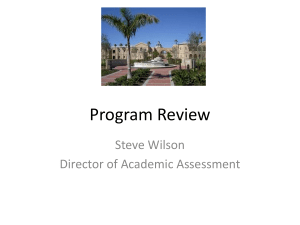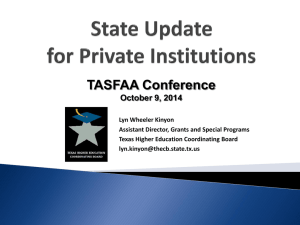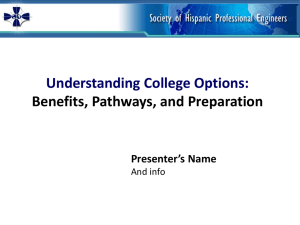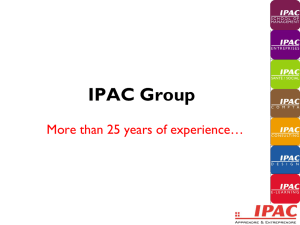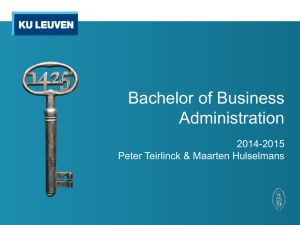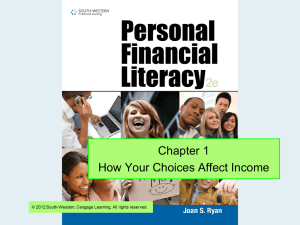Degree Programs - The Texas A&M University System
advertisement
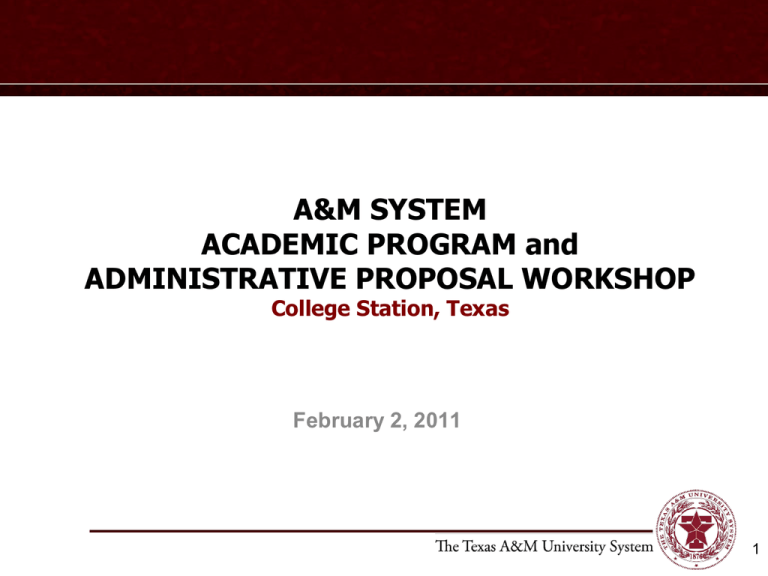
A&M SYSTEM ACADEMIC PROGRAM and ADMINISTRATIVE PROPOSAL WORKSHOP College Station, Texas February 2, 2011 1 Introductions TAMUS •Ken Poenisch, Associate Vice Chancellor AA •Irma Harper, Assistant Vice Chancellor AA •Shauna King, Assistant to the Vice Chancellor for AA •Carolyn Krenek, System Planning and Policy Coordinator •Stacy Flores, Senior Office Associate 2 Introductions THECB Academic Programs Anya Sebastien, Director Van Davis, Special Projects Director Institutional Representatives Please introduce yourself and institution you represent. 3 Objectives Make everyone’s life easier when handling items that go to the Chancellor, the Board of Regents, and the THECB. 4 Objectives • Discuss and demonstrate what we are doing to provide information to institutions regarding preparation and submission of new programs and administrative change requests. • Explain what happens when items are submitted, who to contact and why deadlines are so important. 5 Objectives • Hear from the THECB on what they look for and topics on distance education • Cover a few issues regarding item preparation and submission • Get feedback from institutions and how we can be of greater assistance 6 Item Guidelines • Item format and process are dictated by: – Board of Regents • System Policy 01.04, Items Requiring Action by the Board of Regents • Format of items and required documents – Office of General Counsel to assure legal sufficiency – Chief Business Officer – Chancellor 7 Item Guidelines • Texas Higher Education Coordinating Board – Various Rules found in the Texas Administrative Code Title 19 Education Part 1 • Texas Statutes – Education Code – Chapter 51. Provisions Applicable to Higher Education 8 Why Are These Important? • On July 30, 2009 the THECB adopted rules to streamline the process of approval for most new bachelor’s and master’s degree programs (TAC Ch 5, Subchapter C, Sect. 5.44) as well as for administrative change approval and certificate program approval. 9 Why Are These Important? • These new rules permit automatic approval of a new bachelor’s or master’s degree if an institution and governing board certify certain criteria. • These criteria are found on the signature page of the Certification Form for New Bachelor’s and Master’s Degrees as well as Administrative Changes. 10 Why Are These Important? • Institutions do not want their President’s signature on a document that does not meet these criteria. • For items requiring THECB approval, all engineering, doctoral programs and programs with new costs of over $2M the approval process is the same with very little difference in the submission process. 11 What Are We Doing? • Update Academic Affairs website to provide institutions one location to obtain information about each item, documentation, and resources. • With the retirement of Verna DeWees, AA has reorganized and assigned Shauna King to be institutions’ first contact regarding item submission. 12 Overview of Submission Process • Step 1: Institution submits item(s) by email • Step 2: Shauna will review item: – Determine if BOR and/or THECB approval is needed. – Are all required documents included? – Review document formatting. – Distribute to SME for review. 13 Overview of Submission Process • Step 3: SME will review content and determine if BOR, Chancellor, and THECB criteria are met. • Step 4: SME will discuss with Dr. Ashley if there are questions and brief him on item. • Step 5: Return to Shauna who will submit to Chancellor’s staff or return to the institution for revisions. 14 Overview of Submission Process • Step 6: Chancellor’s staff reviews to assure all BOR’s formatting is correct. • Step 7: Chancellor’s staff submits to the Office of General Counsel to evaluate for legal sufficiency. • Step 8: Returned to Chancellor’s staff for final preparation and signatures. 15 Overview of Submission Process • Step 9: Item(s) submitted to BOR office. • Step 10: Dr. Ashley meets with BOR Chairperson of Academic Affairs Committee to discuss items. • Step 11: BOR approves items. • Step 12: AA submits required documents to the THECB through their AA Administrative Change Request System. 16 Overview of Submission Process • Step 13: THECB sends automated response once item is sent. • Step 14: THECB reviews item and takes appropriate action. • Step 15: If item is approved a letter is sent to respective institution. 17 Deadlines Are Important! • If questions arise item may not be approved at planned meeting date. • Some items are sent out for review by outside experts. • Due date to Chancellor is the date the item should be reviewed and revised if necessary. 18 THECB • Dr. Anya Sebastien – THECB Evaluation of Items • Dr. Van Davis – Issues with Distance Education 19 BREAK Start Back in 15 min. Dr. Irma Harper Overview of AA Website 20 Item Preparation and Submission • Type of Item – Determines who needs to approve – Determines what documents are required • Documents Required – BOR – THECB • Document Format • Information Within Proposal 21 Type of Item TYPES OF THECB PROPOSALS ADMINISTRATIVE CHANGE REQUESTS DEGREE PROGRAMS NEW SPECIFIC TYPES OF ACADEMIC PROPOSAL REQUESTS Required Action Creation of new administrative structure Renaming College Academic Reorganizations requiring new structures BOR to THECB Cost < $2 mil submit with Certification Form BOR to THECB Cost > $2 mil submit full proposal for THECB Approval Modification to existing administrative structures, renaming of departments, academic reorganizations not requiring any new structures Submit proposal to Academic Affairs with Certification form. If approved submits to THECB. Bachelors, Masters BOR to THECB Cost < $2 mil and not Engineering, with Certification form BOR to THECB Cost > $2 mil or Engineering submit with full proposal and THECB must approve Doctoral Step 1 Preliminary Authority: BOR to THECB with full proposal. Step 2 Full Proposal: BOR to THECB with full proposal. Website Degree Programs » Degree program approval includes new bachelor, master, doctoral, cooperative and joint degrees. It also includes the reclassification or modification of degrees. •New Bachelor or Master Degree oNon-Engineering/Does Not Exceed $2 Million oEngineering/Exceeds $2 Million •New Doctoral Degree •Reclassify/Modify •Cooperative/Joint Degree 23 Website Process and Required Documents Non Engineering/Does Not Exceed $2 Million Program Approval: Academic Affairs Board of Regents THECB (Notification) Forms: • Briefing and Minute Order (Word document template) • Program Review Outline • New Program Request Form • Certification Form Resources: • Sample Request • System Approval Checklist (Excel spreadsheet) • Links: o THECB o THECB Flowchart o Standards for Bachelor’s and Master’s Programs 24 Additional Website Resources Document Format: – Chancellor’s Website Agenda Items » Signature Block Style Template Style Guidelines – Communications’ Website A&M System Written Style Guidelines » Referencing the A&M System Referencing other A&M System members 25 Information Within Proposal New Program Request Form (New Degree) – Provides Outline of Required Information to be Submitted in Proposal – Signature Page States Program Meets THECB Standards for Bachelor’s and Master’s Degree Programs • Section 5.45 of the THECB Rules set forth the criteria that must be met in developing new degree programs. 26 Outline For New Program Asks Institution to provide information regarding: I. Need II. Quality III. Cost and Funding 27 Modification to New Degree Proposal Form Proposal Form On Website • Incorporates THECB information • Standards for Bachelor's and Master's • Cost and Funding Tables Forms for calculating costs/funding included 28 I. Need A. Job Market Need – The institution has researched and documented recent and reliable data on the number of potential job openings in the discipline that reflect both short and long-term need. Types of data to be used: • Documented vacancies in existing positions • Documented need for new positions • Evidence of emerging markets For programs that do not lead directly into a job, the institution has documented other justification for the program such as enhancing educational opportunities currently unavailable to students, preparing for graduate education, etc. 29 I. Need B. Student Demand – The institution has researched and documented recent and reliable data of short and long-term evidence of student interest. Types of data to be used: • Increased enrollments in related programs at the institution • High enrollment in similar programs at other institutions • Qualified applicants rejected at similar programs in the state or nation • Student surveys 30 II. Quality A. Degree Requirements B. Curriculum C. Faculty D. Other Resources 31 II. Quality A. Degree Requirements 1. Core Curriculum 2. Number of hours in the major 3. Number of hours in the degree program a. Bachelor's 120 hours unless waiver is requested with compelling academic reason 4. Transfer issues 32 II. Quality B. Curriculum 1. Required courses 2. Prescribed electives 3. Free electives 4. Initial teaching certificate 33 II. Quality C. Faculty 1) Core Faculty - A core faculty member is tenured (or tenure-track) who devotes an average of fifty percent or more of his or her teaching time in the program. (Some programs such as interdisciplinary degrees may have core faculty devoting less than 50 percent of their teaching time to the program.) The background and education of each core faculty member shall be in the field of the program or in a closely related field. 34 II. Quality C. Faculty 2) Support Faculty 3) Qualifications of Faculty for Bachelor’s Programs – To meet minimum SACS standards, 25 percent of faculty supporting the program shall have terminal degrees. Beyond that minimum standard, the percentage of faculty with terminal degrees shall compare favorably to the percentage of faculty with terminal degrees at similar programs in the state and nation. 4) Qualifications of Faculty for Master’s Programs - All faculty supporting the master’s degree program shall have terminal degrees. 35 II. Quality C. Faculty A minimum number of faculty shall be devoted specifically to the proposed program: • Bachelor’s program – three FTE or two FTE if comprised of four individual faculty members. (Note: The standard for upper-level institutions could be lower for those programs in which lower-division courses are required for the major and taken at feeder institutions.) • Master’s program – three FTE or two FTE if comprised of four individual faculty members • At least 50 percent of the faculty FTE supporting a bachelor’s or master’s program must be core faculty. 36 II. Quality C. Faculty What impact will the new program have on current programs in regards to faculty resources? 1. How will the teaching load of current faculty be impacted? 2. How will the teaching load of faculty assigned a portion of their time to the new program be covered? 37 II. Quality D. Other Resources 1) Library Resources 2) Facilities and Equipment 3) Accreditation 4) Evaluation 38 III. Costs and Funding A. Identifiable new and reallocated revenues shall cover the incremental costs of operating the program. B. New formula funding shall not be considered as a funding source for the first two years of the program and shall not exceed 50 percent of all funding for the program for years three through five. C. By year six, the identified sustainable incremental revenue shall be equal to or above the incremental costs. 39 III. Costs and Funding D. Incremental or new costs to the institution shall be below $2,000,000 for the first five years of the program. E. Costs shall include personnel, facilities and equipment, library resources, supplies and materials, administration, and any other new costs directly related to the program. 40 III. Costs and Funding Five-Year Costs Personnel1 Faculty $0 Administration $0 Graduate Assistants $0 Clerical/Staff $0 Other Personnel $0 Facilities, Equipment & IT Resources Other2 Total Costs $0 Five-Year Funding Reallocated Funds $0 Anticipated New Formula Funding3 Other4 $0 Total Funding 41 III. Costs and Funding Footnotes: 1. Report costs for reassigned faculty, new faculty hires, graduate assistants, and technical support personnel. Prorate individual salaries as a percentage of the time assigned to the program. If existing faculty will contribute to program, include costs necessary to maintain existing programs (e.g., cost of adjunct to cover courses previously taught by faculty who would teach in new program). 2. Specify other costs here (e.g., accreditation, travel). 3. Indicate formula funding for students new to the institution because of the program; formula funding should be included only for years three through five of the program and should reflect enrollment projections for years three through five. 4. Report other sources of funding here. In-hand grants, “likely” future grants, and designated tuition and fees can be included. 42 New Costs Tables Within Proposal Cost Category Faculty Salaries Cost SubCategory 1st Year 2nd Year 3rd Year 4th Year 5th Year TOTALS New Reassigned Program Administration New Reassigned Graduate Assistants New Reassigned Clerical/Staff New Reassigned Supplies & Materials Library Equipment& IT Resources** Facilities 43 Item Submission • Email Items: – aa-agendaitems@tamu.edu – Include one item per email – In Subject Line put Institution and Item • Ex. TAMU Admin Change College of Ed 44 Approval Process • Following BOR Approval Institutions are Notified via email • Submitted to THECB if required – Institutions receive email from THECB once item is received – Letter sent to institutions once item is approved 45 New Procedure for Bachelor’s and Master’s Degree Proposals For All New Bachelor’s and Master’s Degree Proposals: 1. 2. 3. 4. 5. 6. Submit Preliminary Approval Proposal Similar to Preliminary Planning Procedure Submit as Regular BOR Agenda Item Will be voted on by BOR Will not be submitted to THECB Authorize institution to prepare full proposal 46 Questions? Issues? Thoughts? How Can We Be of Assistance? 47
